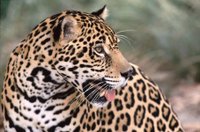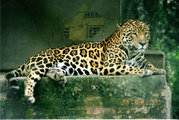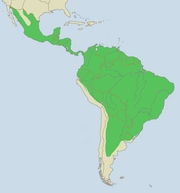Jaguar
The jaguar (Panthera onca) is a large member of the cat family found primarily in the warm regions of the Americas. It is closely related to the lion, tiger, and leopard of the Old World, and is the largest and most powerful feline found in the Americas. more...
Physical characteristics
To some jaguars look very much like leopards but they are sturdier and heavier. The easiest way to distinguish a jaguar from a leopard, beside the jaguar’s much more powerful build, is the rosettes. The rosettes on a jaguar’s coat are larger, fewer in number, and usually darker with thicker lines that enclose smaller spots. The head of the jaguar is much squarer and it has shorter stockier limbs. Because of this the jaguar is sometimes referred to as the “bulldog” of the cat world. The Jaguar, in a recent National Geographic special titled “In Search of the Jaguar,” was named pound for pound the strongest animal in the world.
Jaguars vary from 5.3 to 6 feet (1.62 to 1.83 m) in length, excluding 30 in (0.76 m) tail, stand around 67 to 76 cm (27 to 30 inches) tall at the shoulder, and weigh between 56 and 96 kg (124 and 211 lb) with larger individuals, recorded by scientists, weighing between 131 and 151 kg (288 to 333 lb). Females are typically twenty percent smaller than males. Jaguars in southern Mexico and Central America are typically smaller, 56 kg and 40 kg (123 lb and 90 lb) for males and females respectively. The jaguar has the strongest jaw structure of any feline and second strongest jaw structure of any land carnivore. Relative to size the amount of force exerted by a jaguar's bite is unmatched by other felids. Captive jaguars have been documented putting 1/4 inch (6 mm) dents into bowling balls using their teeth. They are powerful enough to drag an 800-pound bull 25 feet in its jaws and pulverize the heaviest bones.
Habitat
The jaguar's habitat ranges from the rain forests of South and Central America to marshy and even desert terrain in Mexico, but they are rarely seen in mountainous regions. The jaguar's wide range means that it should not be in danger of extinction in the foreseeable future. The species has declined in number in some areas, however, mainly due to habitat loss, especially in rain forests and grassland turned into cropland.
Known for their strong swimming abilities, one of the few cats beside tigers that enjoy water, and climbing abilities, they often prefer to live by rivers, in swamps, and in dense forest with thick cover for stalking prey. They are the largest predator in their range. Jaguars, on rare occasions, are seen as far north as the southwestern United States, particularly in Arizona and New Mexico. The historic jaguar range actually extended as far north as southern California and western Texas. As recently as 2004 wildlife officials in Arizona have photographed and documented jaguars in the southern parts of the state. Presently it is unclear whether recent sightings indicate whether there is a permanent population developing in the Southwest or these cats are simply transients straying over the border from Sonora, Mexico. However, jaguars are a protected species in the United States under the Endangered Species Act and are considered nongame, so wherever they are found in the southwest they are by law generally not to be molested. Fossils of jaguars from as far north as Missouri confirm these cats inhabited much of the Southern U.S. These prehistoric jaguars grew 20% larger than their modern counterparts and must have been quite ferocious. A skull of a glyptodon was discovered in Arizona with puncture holes made by the fangs of a big cat. The jaguar was the first suspect in this case because of its trademarked habit of killing prey by biting through the skull, instead of the neck like other cats.
Read more at Wikipedia.org




